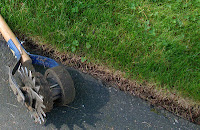The blues are back in our garden.
 |
| The outer sidewalk bed on September 21. Double-click on any image for a full- screen view. |
During the heat of July and August, perennials with yellow
and white flowers dominate our garden. Except
for some heavily watered and regularly fertilized annuals in containers, blue
is almost absent from the color spectrum.
Now, with cooler weather, the blues are back.
The convention wisdom says that September gardens in New
England are ready to be cut to the ground; the season is effectively over. As the attached photos attest, that’s not the
case. Late September brings out a
different side of our garden. The most noticeable
change is that blue flowers are out in abundance for the first time since
mid-Spring. For another, plants are
allowed to play out their natural tendencies, sometimes with stunning results.
 |
| These three containers have merged into one glorious mass of color and texture |
Yes, the first frost will put an end to the annuals. The coleus that is growing with abandon right
now – there are more than a dozen varieties in containers right now - will be
the first to go: even a night with temperatures in the mid-30s will cause them
to wilt. But for the present, they are
taking over the containers that were once dominated by plants that succumbed to
the relentless heat of July and August.
 |
| Blue asters running amok. They've been hiding in plain sight all summer |
The asters have been biding their time, effectively hiding
in plain sight. Now, they are in full
bloom, creating carpets of blue and white all over the garden. Hydrangea are heavy with blooms that are
getting preposterously large; their branches drag the ground. We have three caryopteris at the front of the property. Each is blooming with delicate blue flowers. In the rock gardens behind out home, a large
patch of plumbago displays a carpet
of mid-blue blooms.
 |
| The hydrangea are heavy with preposterously large flower heads |
Foliage plants are also in their glory. We have three varieties of persicaria: Painters Palette, Lance
Corporal and Red Dragon. These are
garden thugs that require constant attention to not take over the beds in which
they are located. Now, as their season
ends, they are throwing up airy stalks containing red seed pods. Our goal is to enjoy the foliage as long as
possible, then cut the plant back to the ground before its seeds mature. It’s a delicate balancing act.
 |
| In the Manhattan bed, an ipomea (sweep potato) vine has been allowed to dominate its container for the final weeks of its season |
Betty is also allowing her containers to ‘naturalize’ for
this, their final month. Throughout the
spring and summer, she has carefully trimmed back individual plants in mixed
containers to maintain a desired shape or color balance. Now, the ipomea
are trailing six-foot-long chartreuse vines.
Three containers have grown into a single, glorious quilt of color and
texture. Off in a corner of the
property, a ‘Big Red Judy’ coleus has ballooned to a height of four feet and a
girth of equal size.
 |
| This caryopteris is one of three on the property, each with blue flowers for September |
From mid-September on, New England gardens live on borrowed
time. Each evening weather report brings
reports of possible frost or freezes a little closer. For the present, it is the Worcester Hills –
some 40 miles distant – that are the target of nighttime temperatures in the
mid-30s. One unexpected drop in the jet
stream could bring that weather to our front doorstep.
And so we are relishing the return of the blues.






